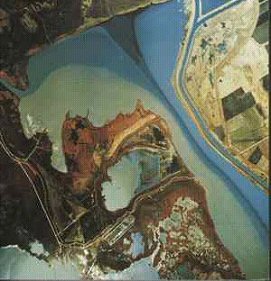Freshwater Inflow 101
In the face of ongoing state-wide water planning, all surface water uses have come under scrutiny, including inflows to estuaries. Freshwater inflows are defined as water draining from the watershed into an estuary. Whether it is in the form of floods or just average runoff, the effects on the receiving estuary are complex and interact with other biological processes. Even during normal conditions on the bay, freshwater mingles with bay water and works its magic, unseen by most anglers. Like the summer breezes, you don't think much about inflows until they're strong enough to disrupt your fishing.
What is so important about freshwater inflows? Basically, there are 3 major functions of freshwater inflow: 1) moderating the salinity of sea water, 2) depositing sediment load, and 3) adding nutrients. If any of these 3 inflow contributions are eliminated, the estuary will be dramatically changed.

Salinity moderation occurs when a fresh water plume fans out through the bay, creating a salinity gradient from the fresh water source to the passes and jetties. This gradient provides fish, shellfish and vegetation of the bay an almost endless choice of salinities to inhabit. This is important because, some species require specific salinity ranges for optimum survival. The salinity gradient formed between the freshwater source and the gulf connection also serves as a migration path for some juvenile organisms to follow on their way to the upper estuary. And, while oysters thrive over a wide range of salinities, extremely low or high salinities may reduce their survival, especially during the hot summer months. Without enough freshwater inflow, the salinity gradient formed would be inadequate to sustain the type of environment most suited to the estuarine marine life.
Sediment load includes the "mud, gravel and rocks" carried from the watershed to the bay. The exact nature of the sediment load is dependent upon the watershed characteristics and the water velocity in tributary. Watersheds dominated by a rocky landscape, like those originating in the Texas hill country, will contribute less sediment load than those dominated by top soil. Though not often recognized as beneficial, the sediments carried to the estuary are critical for the maintenance of such geologic features as deltas, and for the health of plant communities in peripheral marshes. In both cases sediments serve as a substrate where plants root and grow. In turn this vegetation serves as critical habitat for juvenile organisms and also act as a buffer zone between high-energy wave action and beaches susceptible to erosion.
While the term "nutrients" is a little ambiguous, it typically refers to dissolved compounds of phosphorus and nitrogen and decaying organic material such as forest leaf litter. Just as a farmer applies these nutrients to a field for crop preparation, they also fertilize the bay. They are utilized by various small creatures and plants at the base of the food chain which are in turn consumed by larger creatures. In this way the energy within the nutrients moves up the food chain.
When inflows increase due to rains on the watershed, the freshwater plume will become larger; accompanied by lower salinity, expanded salinity gradients and increased sediment and nutrient input. Many species will be forced to change their preferred location within the bay. Some will experience a reduction in preferred habitat and some will see an increase depending on their salinity preference. If the decreased salinity occurs during the warm summer months and lasts for many weeks, some attached species like oysters may die because they cannot relocate.
A reduction in freshwater inflow from drought or diversions will have the opposite affect in most cases. The area of influence by the fresh water plume will shrink and so will the habitat available to the species that require the salinity gradient created by the plume. Oysters will experience increased attack from predators and parasites that thrive in higher salinities. Sediment and nutrient loads will generally decrease with the decreased flow volume and velocity.
In the case of decreased flows the potential for decreased water quality also occurs. Throughout the watershed there are discharges of waste into tributaries which eventually empty into the estuary. These include municipal effluent, industrial effluent and agricultural runoff. These discharges may be diluted during moderate or high flows to non-problematic concentrations. However, during low flows, concentrations of these discharges in the tributary will be higher due to less dilution, and this may reduce the water quality to levels not acceptable to aquatic life.
I hope this introduction into how freshwater inflow affects our bays was informative. Keep in mind that this was a brief, over-simplification of a very complex process that happens all along the Texas coast. The real-life situation is much more complicated, but worth the effort needed to understand it.
© Copyright Texas Parks and Wildlife Department. No part of this work may be copied, reproduced, or translated in any form or medium without the prior written consent of Texas Parks Wildlife Department except where specifically noted. If you want to use these articles, see Site Policies.